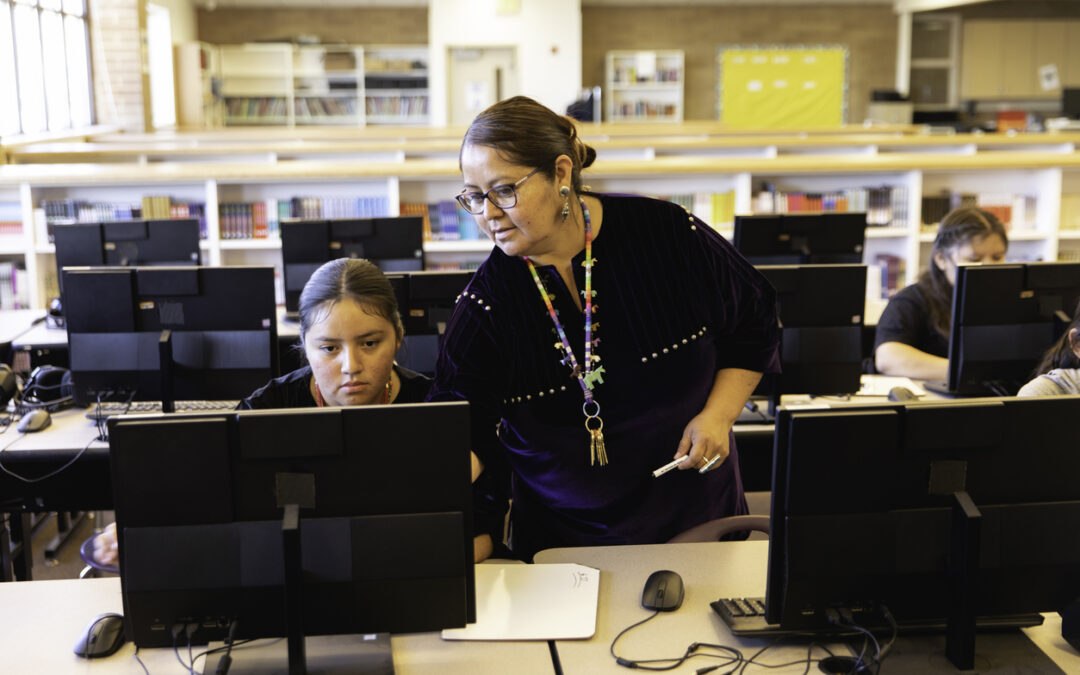Digital literacy is the ability to understand, use, and interact with technology, media, and digital resources in real-world situations, providing the foundation for college and career readiness.
Teaching digital literacy in students requires a range of specific interrelated skills.
Today’s students are considered “digital natives,” regularly using computers, tablets and phones for a variety of purposes. Because of this, it is often assumed that students are automatically digitally literate, but this is not the case.
Without guidance and training, students are left to their own devices – pun intended.
Basic Components of Digital Literacy Skills
Digital literacy skills can be broadly categorized into four components:
Basic Computer Skills: Lay the foundation for digital literacy with basic knowledge around computer fundamentals. This typically includes keyboarding skills.
Computer Applications Skills: Advancing digital literacy by using computer applications to introduce students to a variety of technology functions and use cases.
Computational Thinking Skills: Broaden digital literacy with computational thinking by practicing complex problem-solving skills to develop, test, and refine processes and products.
Digital Citizenship Skills: Hone digital literacy skills with digital citizenship to help students have and manage their online presence by understanding responsible technology use.
Laying the Digital Literacy Foundation with Basic Computer Skills
Teaching digital literacy starts with the basic computer skills students need to use technology. Without understanding computer fundamentals or honing their typing technique, students are stalled in their pursuit of digital literacy.
Understanding Computer Fundamentals
Think of a computer like a car: the basic equipment students will use to connect with the world around them. What if they cannot turn the key in the ignition? Or unscrew the gas cap? In the same way new drivers learn basic skills regarding car use and maintenance, students need to master computer fundamentals to navigate the digital world.
Sample Skills: Recognizing how data can be stored and shared in different file formats and accessed from local storage devices, networked devices and cloud services.
Keyboarding
For all computer-based activities, typing is a minimum requirement. As academic, professional and personal operations continue moving to a digital space, students require requisite typing skills to type notes, complete essays for homework and assessments, and prepare reports and presentations. Moreover, mastery of typing skills like touch-typing is a necessary skill for both school and career readiness.
Sample Skill: Demonstrating proper touch-typing techniques and ergonomic strategies such as correct hand positions and smooth rhythmic keystroke.
Bonus Resource: Explore this infographic to learn about why typing is important for students.
Advancing Digital Literacy Skills with Computer Applications
With basic computer skills, students can begin to explore and familiarize themselves with computer applications, which include programs and tools that offer database, multimedia, presentation, spreadsheet, visual mapping and word processing capabilities. These tools are used in schools and businesses with regularity to organize thoughts, collect data and collaborate with others in digital formats.
Using Databases
The power of the digital world is fueled by data, which is stored in organizational systems known as databases. By introducing databases, educators help students to use, create and search these complex tools that they will encounter in school, careers and life.
Sample Skill: Identifying and navigating common examples of databases from everyday life (e.g., library catalogs, browser search tools and reviewing school records).
Using Multimedia Software
By using multimedia software, students become creators of a variety of content forms that allow them to communicate effectively and express ideas in visually compelling ways. Multimedia design helps to make sense of complex databases and spreadsheets, engages listeners in presentations, improves visual mapping, and captures the attention of readers in word processing deliverables.
Sample Skill: Demonstrating an understanding of basic design principles and strategies to increase the effectiveness of a digital product as viewed by different audiences and in different contexts.
Using Presentation Software Programs
By introducing students to presentation software, they practice verbal communication with tools they will use from classrooms to offices in order to review topical information, disseminate plans and communicate research and findings.
Sample Skill: Understanding how to structure and develop a non-linear presentation.
Using Spreadsheets
Like databases, spreadsheets often contain a wealth of data that can be manipulated, studied and shared. The ability to manage, study, and disseminate data is vital to students’ futures, because data powers much of the decision making in the real world – from medicine to business. Beyond building practical spreadsheet skills, introducing students to spreadsheets cultivates higher order thinking skills as students emerge as young adults.
Sample Skill: Collect data and interpret the results using statistics (range, mean, median and mode) to draw conclusions and make predictions.
Visual Mapping
Visual mapping skills help students use visual formats to gather their thoughts, concept map, illustrate processes and brainstorm.
Sample Skill: Translating an idea or concept into a graphic or digital image to convey a thought, argument or situation.
Word Processing
Extend basic computer skills like keyboarding to produce, format, and store text in order to write paragraphs, short essays, or research papers in common word processing tools like Microsoft Word, Text Edit, Notepad, and Google Docs.
Sample Skill: Identifying and using advanced formatting features (e.g., columns, tab stops, headers and footers, footnotes and endnotes, tables, templates and styles) in word processing applications.
Broadening Digital Literacy with Computational Thinking
Computational thinking leverages higher-order thinking needed for coding, which not only progresses coding skills but also complex problem-solving skills optimized for the digital world.
Computational Thinking
Computational thinking skills are problem-solving skills that leverage the power of computing to find solutions. Computational thinking uses decomposition, pattern recognition, abstraction, and algorithmic thinking to develop efficient and effective solutions. By doing so, students learn to tackle complex problems with transferrable processes and develop skills such as perseverance and adaptability.
Sample Skill: Creating and interpreting visual representations such as flowcharts and diagrams to organize data, find patterns, make predictions or test solutions.
Coding
Coding leverages computational thinking to design programming solutions in a specific coding language to solve problems and create solutions. Beyond computational thinking skills, coding also develops competencies in coding structures such as variables, loops, conditionals, sequencing and functions using block-based and text-based languages.
Sample Skill: Defining an algorithm as a sequence of defined steps or instructions to be followed and identifying how algorithms relate to computer programming and allow for automation.
Honing Digital Literacy Skills with Digital Citizenship
Digital citizenship helps students frame their understanding of what it means to have and manage an online presence that enables them to leverage this technology in productive and beneficial ways while avoiding the inherent risks associated with it. More specifically, digital citizenship encompasses the skills and competencies of responsible technology use.
Online Safety
Building students’ online safety mindset should start as soon as students have access to computing devices. Educated digital users understand the risks of digital tools and are familiar with best practices to ensure their safety.
Sample Skill: Recognizing online threats to privacy and practicing effective strategies to secure and protect personal data from data-collection technologies and malicious software.
Online Communication & Internet Use
Technology opens a vastly connected world of information and people alike. Students must be prepared to manage their digital reputation, interact with others and use computer-based resources
Sample Skill: Understanding the role an online identity plays in the digital world and the permanence of their choices and decisions when interacting online.
Through cultivating digital literacy, students move from passively using technology to creating with it. Moreover, teaching digital literacy helps provide the foundation for students’ futures, ensuring students:
- are adept at navigating computer-based environments and comfortable using software and tools to accomplish tasks;
- know how to safely and effectively manage their digital presence and interactions;
- have complex problem-solving skills that enhance college and career readiness for tech-centric disciplines and beyond.
This article was originally published in 2019, and was updated in 2023 for information, accuracy, and relevance.

Learning.com Team
Staff Writers
Founded in 1999, Learning.com provides educators with solutions to prepare their students with critical digital skills. Our web-based curriculum for grades K-12 engages students as they learn keyboarding, online safety, applied productivity tools, computational thinking, coding and more.
Further Reading
Creative & Responsible AI Classroom Activities for K–12
As AI tools make their way into students' devices, one thing is clear: educators need support in using artificial intelligence in meaningful and...
The Future of Learning: AI Lessons in Schools and Beyond
AI has already had a major impact on how students approach their learning, yet the technology is only just getting started. Wondering what else is...
Why Digital Safety Matters: Keep Your Kids Safe & Healthy Online
From schoolwork to texting friends, and gaming to streaming tv, children today are spending more time than ever on screens. In fact, an average of...




